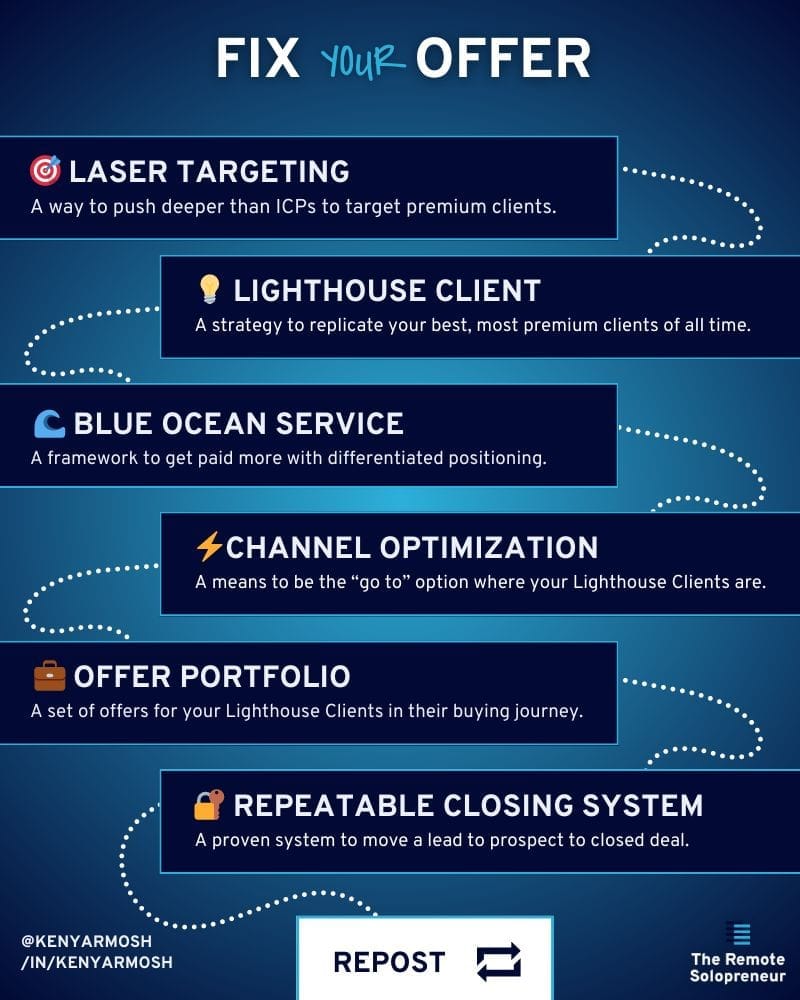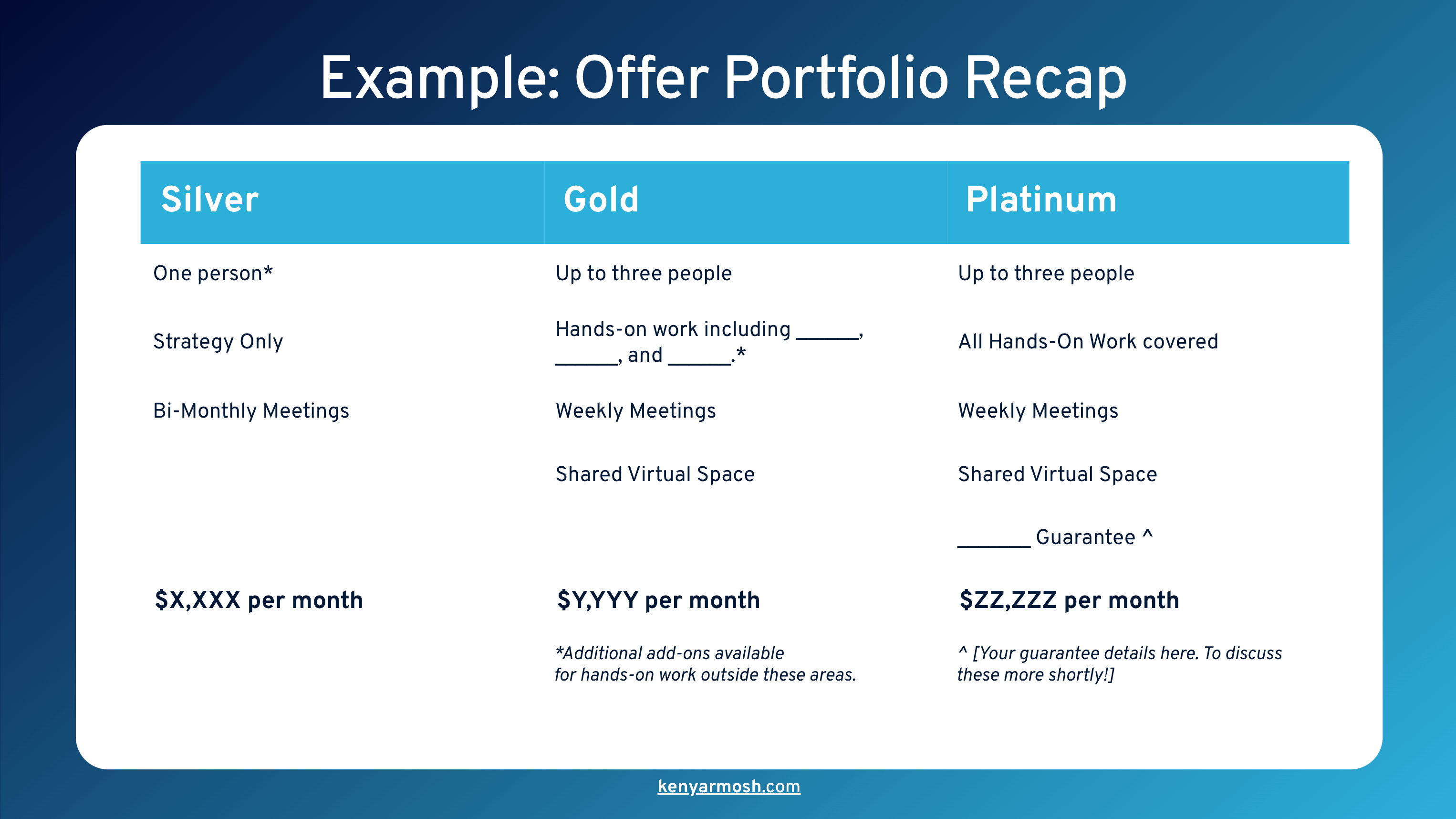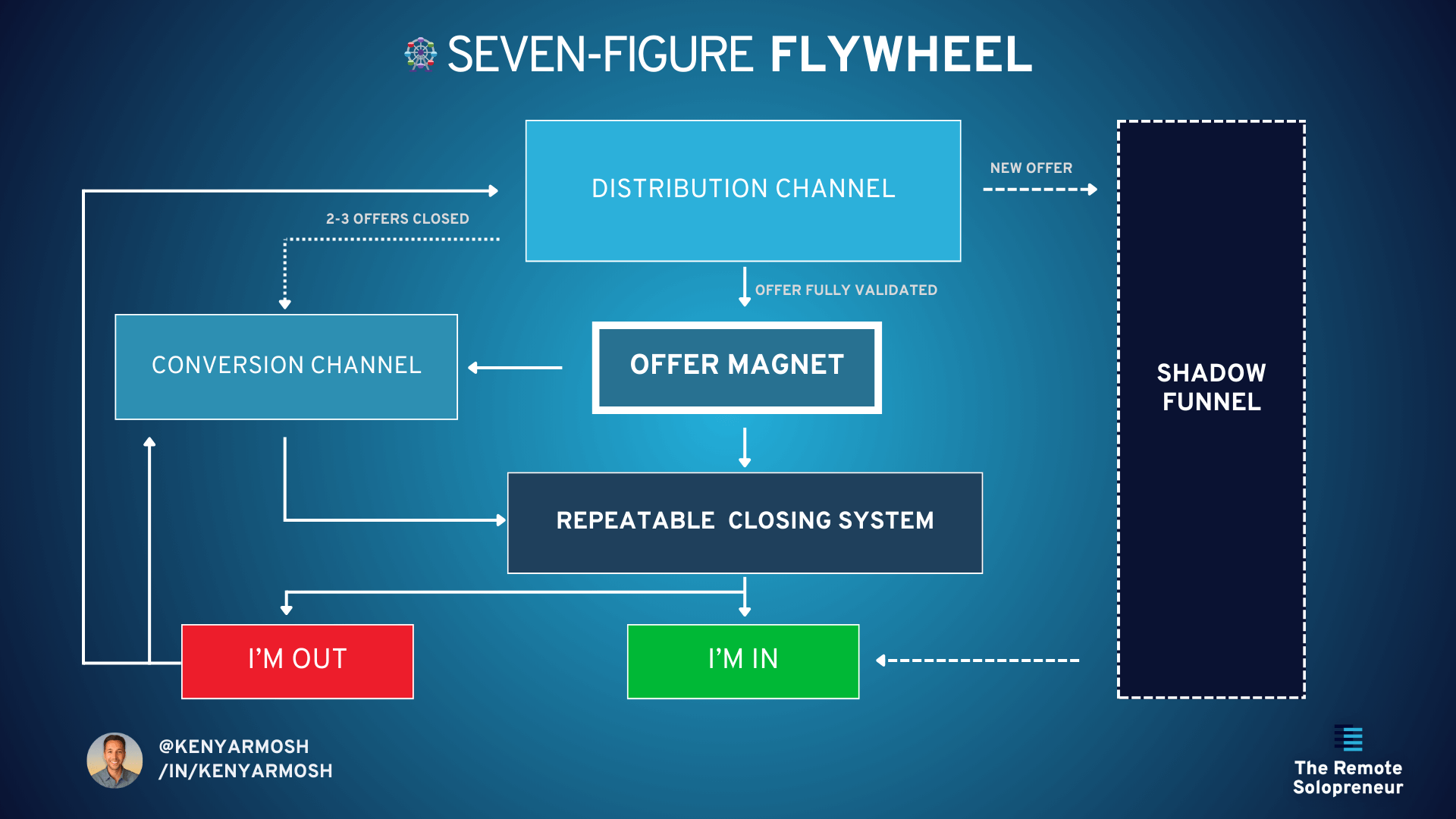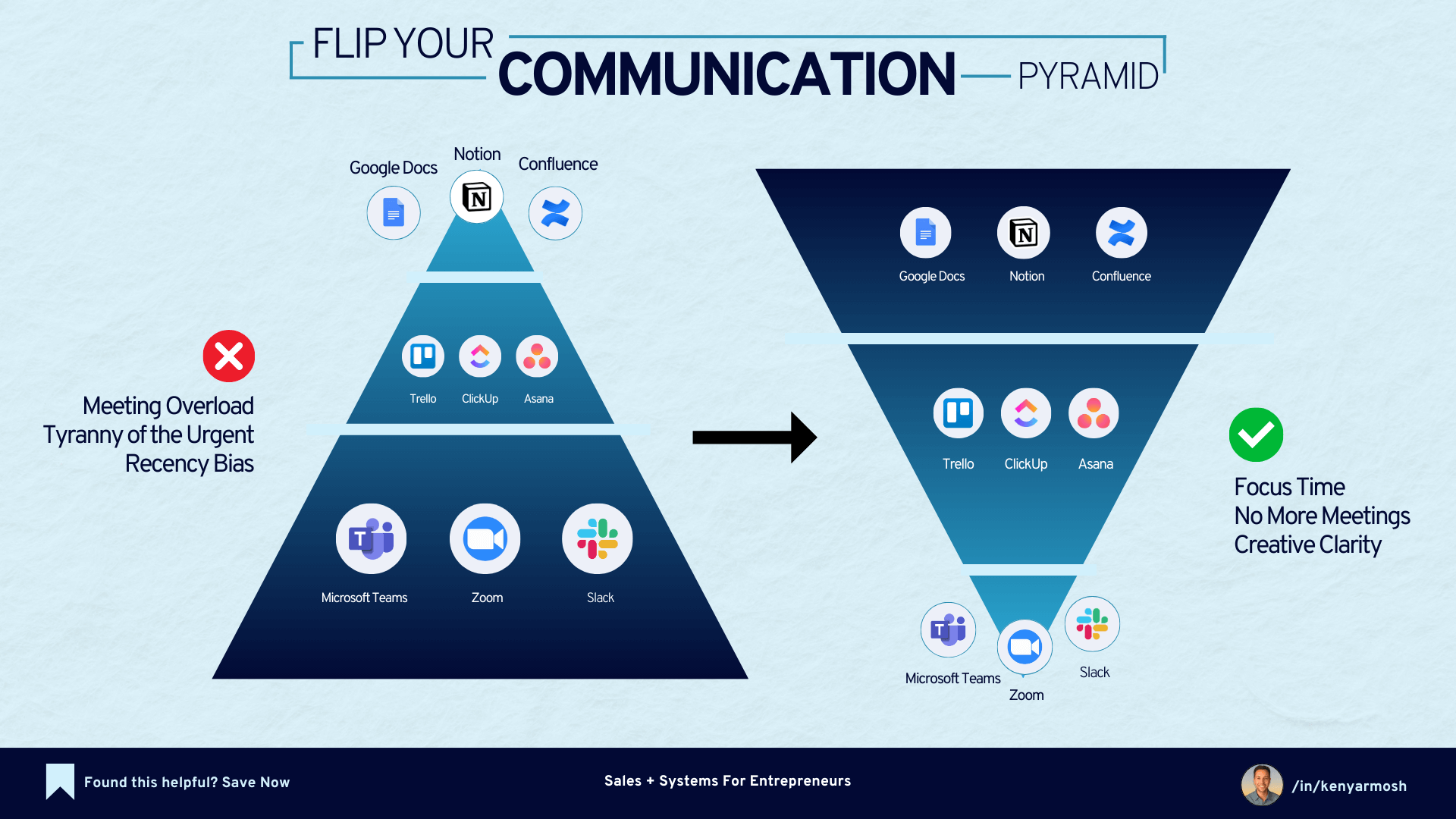🚀 TL;DR
- Many solopreneurs stay stuck despite full calendars—from working harder, not smarter.
- True scale = more impact & profit without a proportional increase in time or effort.
- Fix your offers, your client fit, and reduce overservicing to protect margins and sanity.
- Build repeatable systems in marketing, sales, delivery; use async work and reusable assets.
- Use outcome-based pricing, run in strategic sprints, measure key metrics, and only hire after processes are solid.
Almost every solopreneur hits a growth ceiling and wonders about hiring or what to do next. That's the dirty secret nobody talks about.
I meet freelancers and consultants who've mastered their craft but remain trapped in what I call "delivery hell" — stuck in a loop of custom work, overservicing clients, and reinventing the wheel with every new project.
Their calendars are full. Their bank accounts aren't.
After two decades of building multiple seven-figure businesses, I've discovered the real breakthrough comes when you stop thinking about scaling in terms of more hours or more people. The solopreneurs who truly thrive aren't working harder — they're designed differently from the ground up.
Your path to freedom isn't through hiring. It's through leverage.
In this guide, I'll show you exactly how to transform your one-person hustle into a structured, sustainable business using a service business strategy that can grow without crushing your soul in the process.
1. Decide what "scale" means (before you chase it)
First things first: what does "scale" actually mean for a one-person business?
The traditional definition involves hiring employees, opening multiple locations, and pursuing hockey-stick growth. That path turns creative experts into people managers practically overnight.
Scale for solopreneurs means something completely different: increasing your impact and income without proportionally increasing your time and effort.
Real scale comes from three elements:
- Leverage: Creating systems that multiply your effectiveness
- Freedom: Building operations that don't require your constant presence
- Cash: Generating healthy profit margins, not just revenue
Before you chase someone else's definition of growth, write your own. Define exactly what a successful scaled business looks like for you in terms of working hours, income, and lifestyle.
Don't mindlessly copy startup growth models or agency structures. Design a business that leverages your unique strengths while protecting what matters most to you — your time, creativity, and independence.
2. Fix "bad leads, bad offers"
When solopreneurs struggle to grow, they usually blame marketing: "I need more leads!"
But flooding a broken system with more prospects doesn't fix the problem. You need to diagnose what's actually happening with your offer and lead fit.
Four possible states exist:
- Good leads, good offer = consistent growth
- Good leads, wrong offer = frustrated prospects
- Bad leads, good offer = wasted sales efforts
- Bad leads, wrong offer = complete stagnation
Most service businesses suffer from misalignment between their target clients and what they're selling. The solution isn't more traffic — it's getting clear on your Lighthouse Client (the ideal customer who guides your business decisions) and creating service offerings that solve their specific problems.
Start measuring conversion rates at each stage of your process. Track how many prospects convert to calls, and calls to clients. This data reveals whether your issue is lead quality or offer structure.
Fix the offer before scaling your marketing. You can't outrun a bad fit with more volume.

3. Commit to one Offer Portfolio (and say no)
Trying to be everything to everyone creates a business that excels at nothing.
The most successful solopreneurs build one cohesive Offer Portfolio — a small set of related services designed for the same ideal client. These offers work together, creating a clear journey from entry point to premium service.

Strategic focus demands disciplined rejection. Decide what you won't do. Establish clear boundaries around the types of projects you'll decline, industries you won't serve, and price points you won't accept.
These boundaries might feel restrictive but create the foundation for sustainable growth. When you stop context-switching between unrelated services, you can build systems that deliver consistent results.
Each new client becomes easier to serve than the last because you're refining the same processes rather than reinventing your approach for every project.
Focus on one Offer Portfolio serving one Lighthouse Client. Then standardize every element — from delivery timelines to expected outcomes. Your business becomes truly scalable when clients receive a consistent experience regardless of when they work with you.
4. End overservicing (protect margins)
Overservicing clients feels generous in the moment, but destroys your business over time.
When you routinely exceed scope, you train clients to expect more than they pay for. This creates three critical problems. Your margins erode as you work unpaid hours. Your delivery becomes inconsistent and impossible to systematize. And resentment builds, eventually leading to burnout.
Replace the "always available" mindset with clear service boundaries. Define precisely what's included in each offer — number of revisions, response times, deliverables, and support levels. Document these boundaries in your client agreements.
Implement structured communication channels rather than being constantly accessible. Replace "anytime" availability with scheduled office hours or asynchronous updates.
Track your time meticulously, even if you don't bill hourly. This data reveals which clients and projects consistently exceed estimates, helping you refine your offers and pricing.
The most valuable asset in your business isn't your client list — it's your focus. Protect it ruthlessly with boundaries that preserve both profitability and your sanity.
5. Build systems across marketing, sales, and delivery
Systems transform freelance work into a scalable business.
Start by mapping your client journey from first touchpoint through delivery and beyond. Then build repeatable processes for each stage.
Your marketing systems could include a content calendar with a repurposing strategy, lead capture and nurturing sequences, and consistent visibility in one primary channel.
For sales, develop a qualification questionnaire to filter prospects, a standardized consultation structure, and proposal templates for each service tier. Your delivery systems need a client onboarding sequence, project management templates, and a regular check-in and reporting cadence.
Begin manually to understand what works. Once you've confirmed that the process delivers results, templatize it. After proving the template works consistently, look for automation opportunities.
Documentation is the bridge between freelancing and business ownership. When your methods exist outside your head, you create assets that generate consistent results without requiring your constant attention.
The goal isn't to remove your expertise from the equation — it's to apply that expertise more strategically by eliminating repetitive tasks.
6. Price for leverage (not hours)
Hourly billing creates a direct link between your time and income. That's the opposite of leverage.
Shift to outcome-based pricing that reflects the value you create rather than the time you invest. This fundamental change separates your revenue from your hours, creating the foundation for true scalability.
When pricing your services:
- Set minimum engagement thresholds that make projects worth your time
- Create clear tiers that offer different levels of access and support
- Include premium options for speed or additional strategic input
The most profitable solopreneurs establish a "good-better-best" structure that gives clients options while maintaining healthy margins at every level.
Track your effective hourly rate across projects by dividing revenue by time invested. This metric reveals which services and clients generate the most leverage.
Raise your rates with each capacity pinch — when your calendar fills up, it's a market signal that your services are underpriced. Use this data to continually refine your pricing strategy.
7. Replace leaky funnels with a flywheel
Traditional marketing funnels depend on constant new leads. One interruption in your lead flow and revenue immediately suffers. That's an exhausting, precarious way to run a business.
Instead, build what I call the Seven-Figure Flywheel — a system that generates momentum through three connected forces. Focus on retention by keeping clients longer through exceptional results. Emphasize expansion by growing revenue from existing relationships. And prioritize referrals by turning satisfied clients into advocates.

This flywheel creates sustainable growth without the constant pressure of finding new prospects. Each satisfied client becomes an asset that generates ongoing value.
Create an Offer Magnet — valuable content consistently attracting your ideal clients — and pair it with automated nurturing systems that maintain relationships until prospects are ready to buy.
Track client lifetime value and referral rates as key performance indicators. These metrics reveal the health of your flywheel and highlight opportunities for improvement.
The flywheel approach gives you stability and predictability that funnel-dependent businesses can never achieve.
8. Make sales scalable
Sales become the bottleneck for many growing service businesses. Custom proposals, endless follow-ups, and objection handling consume valuable time that could be spent on delivery or strategic growth.
The secret to scalable sales isn't better closing techniques — it's fixing your offer so objections disappear before they arise.
Create a qualification process that identifies ideal clients before you invest significant time:
- Fit: Do they match your Lighthouse Client profile?
- Urgency: Is their timeline aligned with your capacity?
- Budget: Can they afford your minimum engagement?
- Authority: Can they make purchasing decisions?
Standardize your proposal process with modular templates that can be quickly customized for qualified prospects. Include social proof specific to each client's industry or challenge.
When objections consistently arise, fix them in your marketing or offer structure rather than addressing them individually in sales conversations. This systemic approach creates a more efficient sales process that scales without requiring more of your time.
9. Design delivery for async and reuse
The traditional service delivery model relies heavily on synchronous communication — meetings, calls, and real-time collaboration. This approach creates a hard ceiling on how many clients you can serve.
Redesign your delivery model around asynchronous communication and reusable assets. Replace status meetings with templated async updates. Create a knowledge base of resources that clients can access without your direct involvement. Develop reusable frameworks that standardize your approach across projects.

Set clear expectations during onboarding about how and when you'll communicate. Train clients to work within your systems rather than adapting to their preferences.
Establish work-in-progress limits that prevent overcommitment. Define the maximum number of active projects you'll manage simultaneously at each service tier.
This structured approach might initially feel less personal, but it improves the client experience by creating consistency and reliability. Clients receive better results when you're not stretched thin across too many concurrent projects.
10. Operate in sprints and build 2030-proof foundations
The most successful solopreneurs think in sprints, not days. They operate with strategic time blocks focused on specific business improvements rather than reacting to daily demands.
Implement quarterly planning cycles with clear objectives:
- One offer improvement
- One system enhancement
- One demand generation initiative
These focused sprints create compound growth over time. Each improvement builds on previous work, creating a business that becomes more valuable and efficient with each cycle.
Distinguish between trends and foundations in your strategic planning. Trends come and go — AI tools, social platforms, marketing tactics — but foundations endure: client relationships, intellectual property, and systems.
Invest 80% of your strategic time in building durable assets that will remain relevant in 2030, not chasing the latest marketing fad or business trend.
This long-term perspective creates sustainability that fad-chasers can never achieve. You'll build a business that withstands market shifts while competitors constantly pivot from one shiny object to the next.
11. Measure what matters
Data overload paralyzes many solopreneurs. They track dozens of metrics without clear priorities or actionable insights.
Simplify your measurement approach with a focused KPI set that directly connects to business outcomes.
For marketing, track lead velocity (new qualified prospects per week) and channel efficiency (cost per qualified lead by source).
On the sales side, monitor conversion rate (percentage of prospects becoming clients) and sales cycle length (average days from first contact to closed deal).
For delivery, measure gross margin by service tier, time-to-value (how quickly clients see initial results), and net revenue retention (expansion revenue from existing clients).
Choose no more than 2-3 metrics in each category. Review them monthly and make one strategic adjustment based on the data. When experimenting with new approaches, isolate variables to understand what's working. Change one element at a time rather than overhauling multiple systems simultaneously.
This disciplined approach to measurement creates clarity that guides decision-making. You'll build confidence in your growth strategy because it's based on evidence, not guesswork.
12. Hire last (process first)
The conventional wisdom says growth requires hiring. But premature hiring often creates more problems than it solves, especially for solopreneurs.
Adding people to broken processes simply creates expensive chaos. Instead, follow this sequence:
- Document the current process
- Optimize it for efficiency
- Template repeatable elements
- Automate what doesn't require human judgment
- Only then, consider hiring for specific, well-defined roles
When you do hire, start with contractors for discrete tasks rather than employees for ongoing roles. This approach gives you flexibility while you refine your systems.
Create detailed standard operating procedures (SOPs) for any task you might delegate. These documents serve as training materials and quality control guidelines, ensuring consistent results regardless of who performs the work.
Maintain direct client relationships even as you delegate backend work. Your expertise and client communication remain your most valuable assets and shouldn't be the first things you outsource.
This systematic approach creates a business that can scale through leverage rather than headcount.
Build a business worthy of your expertise
Most service providers never make the transition from freelancer to true business owner. They remain trapped in a model that limits their income, impact, and freedom.
The path I've outlined transforms your expertise into a sustainable, scalable asset.
You'll build a business that generates income without consuming all your time. You'll create consistent results through systems, not heroics. You'll attract ideal clients who value your approach and provide the freedom and flexibility that drew you to solopreneurship in the first place.
This journey requires intention and discipline. You'll need to make strategic choices about what you offer, who you serve, and how you operate. But these decisions create the foundation for lasting success.
The solopreneur path offers something the traditional business model can't: the ability to build a thriving business on your own terms, without sacrificing your independence or creative control.
Your expertise deserves a business model worthy of it. Start building yours today.

